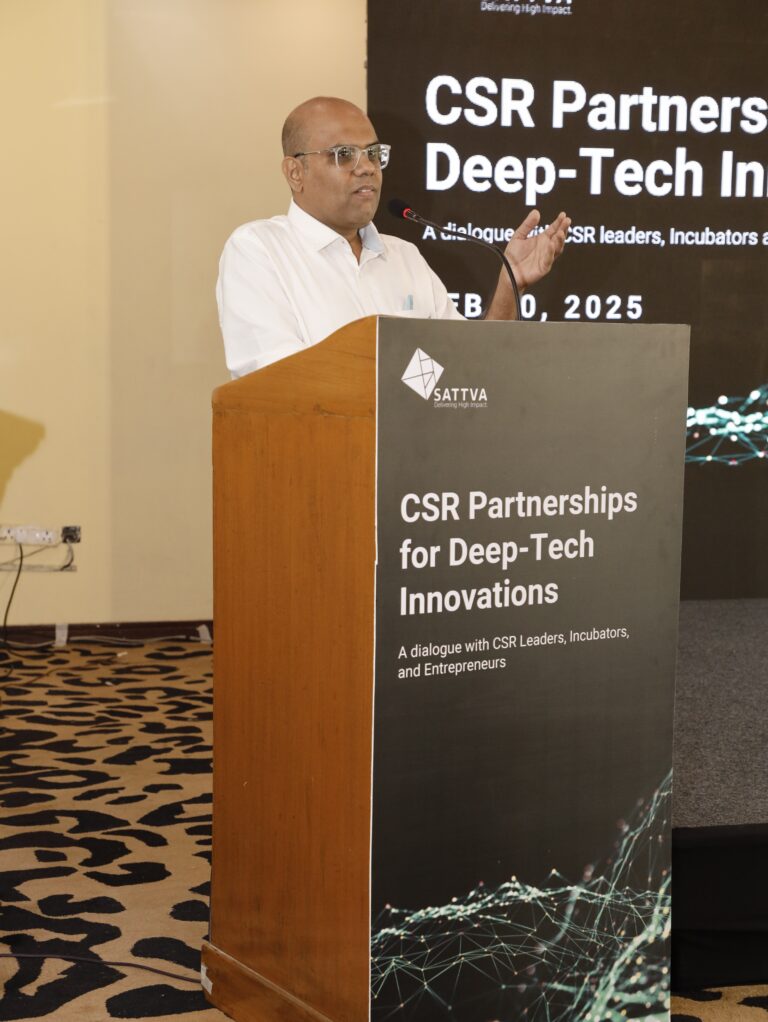Vipul Arora
Environmental, social and governance (ESG) is a term that has gained increasing importance in recent years, particularly for corporations and investors in these enterprises.
ESG is a research and analysis framework that allows ‘Institutional Investors’ and Companies to assess their risks and opportunities, with respect to their environmental, social, and corporate governance performance.
ESG metrics provide a more holistic view of a company, far beyond traditional financial analysis and research. No wonder, it has gained so much popularity among all stakeholders, primarily companies and investor ecosystem.
Journey thus far
Although ESG as a term was coined only in 2004 by the UNEP – FI (finance initiative) team, the underlying causes driving its growth were already in place for a long time. The origins of ESG can be traced back to the 1970s when the United Nations Conference on the Human Environment was held in Stockholm, Sweden to discuss environmental issues for the first time at a global level, and it resulted in the creation of the UN Environment Program (UNEP).
In 1987, the concept of sustainability was first defined in the Brundtland Report. Sustainability can be referred to as a state of balance between consuming what we need today vs the needs of the future. ESG as a framework or tool can help measure and indicate whether that balance exists or not, in the lens of the various stakeholders who influence or get impacted by the business choices. Hence, ESG becomes a tangible structure to realise sustainability within a company as it becomes a compass, highlighting whether a company is moving towards sustainability or away from it.
This has been the greatest contribution of ESG — it has made sustainability tangible and achievable and hence accelerated the progress of companies in becoming Sustainable.
In the 1990s, the International Finance Corporation (IFC) developed the Performance Standards on Environmental and Social Sustainability. This was followed by the establishment of various organisations to provide a more rigorous and comprehensive set of frameworks and standards to support ESG analysis. UNGC, GRI, CDP, SASB, TCFD, SDG’s, ISSB and others evolved over a period of time as reporting frameworks which also gave direction by means of setting expectations.
The European Union Action Plan on Sustainable Finance has laid the foundation for a range of legislations that have emerged from Europe, mandating companies to implement ESG.
The US is not far behind. Securities and Exchange Commission (SEC) proposed a new rule that requires publicly traded companies to disclose information on their ESG policies and performance.
In India, the Business Responsibility and Sustainability Report (BRSR) standard has emerged as part of a new mandate from the Securities and Exchange Board of India (SEBI). From FY 2022-23, SEBI has made it mandatory for the top 1000 listed companies to submit their BRSR report to the stock exchanges as part of their annual report.
In the early 2000s, ESG became increasingly popular among investors. Leading this investor adoption was UN PRI: UN-backed Principles for Responsible Investment, a non-profit set up in 2006. PRI is a voluntary, member-based organisation where investors and service providers commit to use ESG as a framework across the investment and research processes.
As of 2022, Global Institutional Investors managing more than $121 trillion AUM (assets under management) had signed up to the UN PRI committing to use ESG principles in their investment decisions.
This growth in investor demand has led to the creation of ESG indices and investment funds that focus on companies with high ESG scores. Supporting this ESG-focused investment effort was the proliferation of ESG Ratings. Similar to credit ratings, ESG Ratings are issued by research and data organisations that collect ESG data, perform analysis and issue scores to companies around the world.
Over the last two decades, ESG has grown rapidly, and today, ESG-focused investing is a multi-trillion-dollar industry.
Where are we headed?
The EU’s Action plan on Sustainable Finance is leading to a plethora of regulations that will not only affect companies based in Europe but also all those that are doing business in Europe. These include mandatory reporting or the principle of — comply or explain.
SEBI is considering a move to potentially introduce mandatory assurance of certain core ESG data disclosed by the top 250 companies in the financial year 2023-24 and eventually make it compulsory for the top 500 companies in the fiscal year 2024-25 and the top 1000 companies in the financial year 2025-26.
Proactive planning and preparation are necessary for these developments.
There is a sense of urgency among the more progressive companies to be ahead of the compliance requirements. We recommend an early start. Compliance with such reporting requirements needs structural shifts and even transformation in the way a company runs its operations and sources its data internally and from its stakeholders. Implementing such structural shifts and transformations is a time-consuming effort. Noncompliance has a significant cost – possibility of losing their listings or the reputational risk of being fined.
Why has ESG been gaining importance?
While the political debate in the US has tried to paint ESG as irrelevant, there are many fundamental reasons for the growth of ESG:
- Stakeholder demands: The biggest driver is increasing investor demand, as mentioned earlier. Investors who look at an ESG report or ESG rating, in addition to the company’s financial report and credit rating, are better informed about the current and future risks. It is not surprising therefore that investors have been a driving force behind the increasing momentum of ESG. In addition, other stakeholders are also demanding companies to disclose their 360 degree impact.
- Push for Corporate reporting: Owing to increasing demand from investors, the use of ESG to report corporate performance has been growing. Disclosures have also emerged to be a strong communication and messaging tool for the Corporations to convey its commitment and vision to the broader audience.
- Higher ESG Ratings driving down the cost of capital: Increased investor appetite for ESG analysis has led to the emergence of ESG Rating agencies that rate companies on their ESG performance vis-à-vis their industry peers. Similar to credit ratings, companies that rate high (ex AAA) on ESG ratings get greater access to capital, at a lower cost, and improve their market capitalisation as well as reputation. This provides an incentive for companies to disclose more and perform better on ESG over time.
- ESG Performance creating value: ESG has become a strategic tool for the board and top leadership of a company to understand and improve the drivers underpinning its financial performance. The ability to access key drivers of value is a significant enabler for board and top leadership to consistently create value in the longer term. We will see an example later of how companies like Unilever have leveraged ESG as a strategic driver for value creation.
- ESG Alpha: ESG applied rigorously, correlates well with the company’s future financial performance. There has been increasing recognition that several ESG policies and operating indicators are leading metrics of a company’s future financial performance. This correlation has further fuelled the mainstreaming of ESG in the Investment world.
- Regulatory push: Owing to the significant momentum ESG has gained in the last 20 years, regulators in South Africa, Europe, India, Singapore, and the USA have started to pass legislations that demand companies to proactively manage and report their ESG performance. Any company that does not comply with them will not be able to operate in these jurisdictions or list in their capital markets.
However, it is not only the investors that have fuelled the growth of ESG. Most progressive corporations have leveraged the power of ESG to derive superior financial returns. Their positive experience has also shaped the narrative and led to greater adoption of ESG as the most powerful tool in the business world to achieve sustainability as a business goal.
For example, Unilever, an FMCG giant that operates in a hyper-competitive industry with typically low margins, has been implementing an ESG guided strategy since 2010, called Unilever‘s ‘Sustainable living plan’.
As a result, its operating profit has increased consistently, from 6.4 billion USD in 2011 to 8.3 billion USD in 2020 – a 30% growth in operating profit over those 10 years, while its total revenues increased only 10% in the same period from 46 billion USD to 50 billion USD.
It was a result of their conscious pursuit of ESG and Sustainability led strategy as chronicled by their CEO Paul Polman in his book ‘Net positive’. Alan Jope, the current CEO of Unilever also gave credit to ESG and Sustainability for achieving this result: “We’ve taken 1.2 billion euros of cost out of the business through sustainable sourcing. We know it reduces risk…”
Hence, ESG, if applied rigorously, delivers value through Stakeholder capital maximisation.
On the other hand, Volkswagen is one example of a company that preferred to pursue shareholder wealth maximisation as its primary objective, even at the cost of harming its stakeholders. In 2014, it came to light that Volkswagen knowingly violated the U.S. Clean Air Act. It deceived the United States Environmental Protection Agency (EPA) with false engine emissions data for their Diesel TDI engines that were in use since 2006.
It had sold approximately 11 million cars worldwide with this flaw. By 2017, the scandal had cost Volkswagen $33 billion and landed its top leadership in the US in jail.
Having learnt the lesson, Volkswagen announced plans to invest $50 billion in building electric cars in 2018. It would have been far cheaper for Volkswagen’s shareholders if its Board and leadership had invested in electric cars in 2006, a good 12 years earlier. Had they done so, Volkswagen’s shareholders would have avoided a loss of $30 billion in direct costs of the diesel scandal and unaccounted losses in terms of reputation damage and business opportunity cost for being late in the electric car transformation of the business.
These examples have some key lessons:
- There are no shortcuts on the road to value creation. It is not possible to create consistent, long-term shareholder value by ignoring or harming the stakeholders.
- On the contrary, Stakeholder capital maximisation has proven to be a far superior strategy to shareholder wealth maximisation. To be successful, a company needs to aim for stakeholder capital maximisation. Shareholder wealth creation will be a natural outcome of this process.
- ESG has emerged as a powerful tool in the hands of Boards and Executives to pursue Sustainable value creation for stakeholders and shareholders.
So, what can an organisation do?
- Evaluate the current state: Have an honest assessment of its place on the ESG maturity curve. Benchmarking with peers and looking at global best practices can help. However, the biggest value will appear from interacting with its stakeholders.
- Strategise a road map for the future: Create its ESG road map relevant to its operating context. The ‘one size fits all’ approach will not work and may even backfire. A successful ESG strategy has to be relevant to the context of the company.
- Invest: Commit resources and demonstrate commitment in clear, tangible ways. Mere tokenism will lead the organisation on the path of greenwashing, causing greater harm in the long run.
- Execute: Begin its ESG journey once all the ingredients are in place. It takes a rock solid ESG Strategy and a champion team to deliver it. A suboptimal mix will not yield the desired results.
- Seek help: Avoid the temptation of walking alone. Significant challenges appear when we change the way organisations work. Hence, the right hand holding and support are critical to ensure success.
If you wish to discuss your ESG journey with us, reach out to: esg@sattva.co.in




